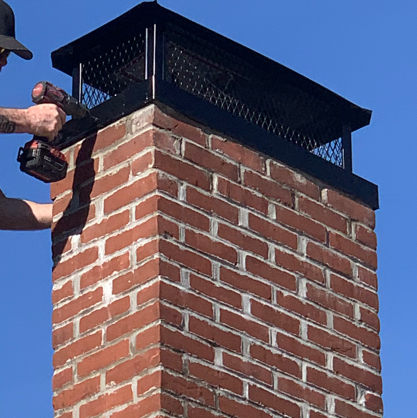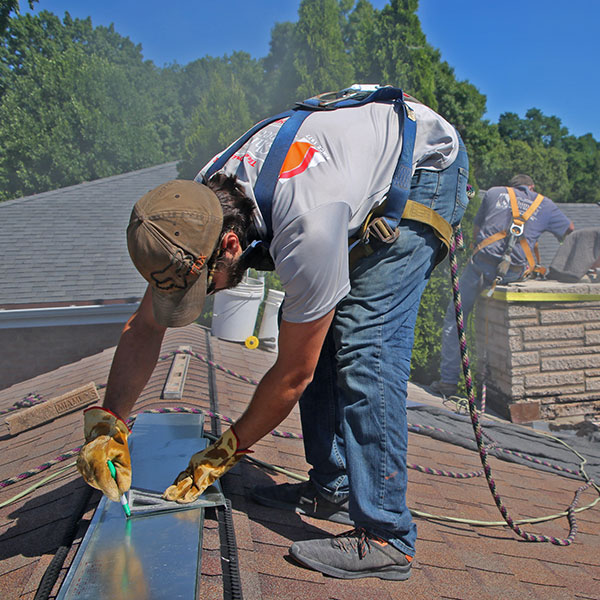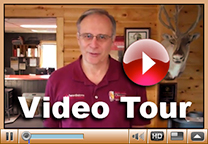Winter Chimney Risks
The Long-Range Weather Forecast predicts temperatures below normal for much of Wisconsin in the 2021-2022 season. Winter poses several risks to chimneys, from freezing rain and snow to gusty winds and hail. Not only can it affect its structural integrity, but it can also make it unsafe to use your wood or gas-burning fireplace. Since many areas of Wisconsin are already experiencing snow, taking the necessary precautions now to protect against these four common winter chimney risks will help keep your family warm and safe this season.
 Damaged or Missing Chimney Cap
Damaged or Missing Chimney Cap
The chimney cap is the chimney’s first line of defense against moisture intrusion. However, its location on top of the chimney makes it susceptible to strong winds, hail, heavy snowfall, and winter storm conditions. When the chimney cap breaks or blows off the roof, your chimney is exposed to external weather conditions. In addition to rain and snow dripping into the fireplace that can damage the interior masonry, very windy conditions can cause a dangerous downdraft that pushes smoke, soot, and debris through the fireplace and into your living area. The irritating smoke and toxic fumes can be harmful to health.
Spalling Bricks
When your masonry chimney was initially built, the exterior brickwork had a hard outer shell to protect the porous material against moisture intrusion. However, the continuous exposure to winter weather conditions and extreme temperature swings can eventually cause tiny cracks in the bricks and erode the mortar. When the rain-soaked masonry freezes, the expanding ice crystals widen the cracks further, causing the bricks to flake, chip, crumble, or spall. The gaps in the mortar joints from the spalling bricks and decaying mortar can also result in bricks loosening and falling from the chimney. Spalling bricks is a severe issue that increases fire risk and exposure to dangerous carbon monoxide fumes, making it unsafe to operate your fireplace. It can also allow water to leak in the chimney resulting in extensive water damage and severe chimney structural issues.
Flue Obstruction
A flue obstruction is another common winter chimney risk. Leaves, twigs, and flying debris can clog the flue obstructing the venting of smoke and harmful fumes. In addition to reducing the heating efficiency and increasing sooty and creosote deposits, a flue obstruction can lead to a dangerous backdraft that causes smoke and fumes to fill up inside your home, exposing your family to toxic carbon monoxide. Chimneys are also a favorite nesting spot for small birds, squirrels, chipmunks, and even mice. They often take up residence in chimneys in the winter, entering through a damaged or missing chimney cap. They can also squeeze through small gaps in the masonry. These critters are more than a noisy nuisance; they can make a mess in the chimney and also cause a flue obstruction.
 Chimney Leaks
Chimney Leaks
Chimney leaks are another winter hazard. Some common causes of chimney leaks are damaged or missing chimney caps, cracks in the chimney crown, spalling bricks, and worn flashing. Signs that your chimney has a leak, include:
- water inside the firebox,
- condensation on the chimney liner,
- water stains around the ceiling or walls near the fireplace, or
- smell a musty odor.
Is Your Chimney Prepared for Winter?
The only way to know for sure whether your chimney and fireplace is not a fire or health risk this winter is to schedule an annual chimney inspection and cleaning. Our CSIA-Certified chimney sweeps serve communities throughout Southwest Wisconsin, Northwest Illinois, and Northeast Iowa. If we detect an issue with your chimney, our professional chimney technicians will provide the required repairs so that your fireplace and chimney will be safe to operate.







